Mercy Flight Central: Critical Care in the air
by D.E. Bentley –
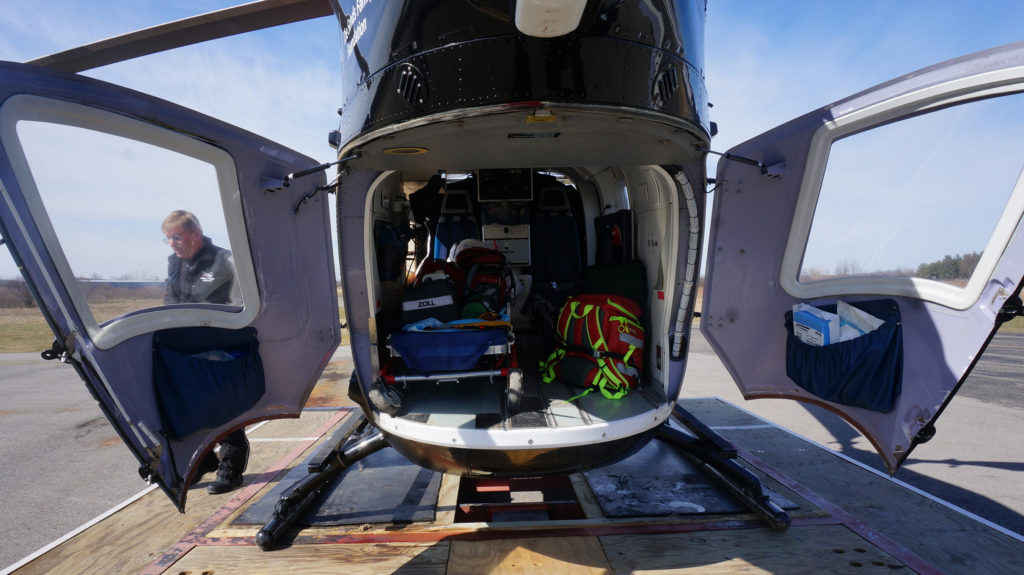
Most people in the United States will roll through life in relative good health. Far fewer will ever experience a life threatening accident. Nonetheless, illness and accidents happen – if not for us then for someone near and dear. We never know when we will get that call. For the dedicated individuals who are a part of Mercy Flight Central (MFC), waiting for the call and dealing with emergency situations is something they do 24/7.
Mercy Flight Central is a non-profit Air Medical Company serving the rural and suburban population of New York from locations in Canandaigua, Rome and Marcellus. Their pilots and medical personnel come to the job with years of flight and Advance Life Support training and experience – which for many includes active military experience.
During a recent visit to Mercy Flight Central’s headquarters in Canandaigua, NY, I had the privilege of speaking with some of the many people connected with this impressive non-profit, which has been in operation since 1992.
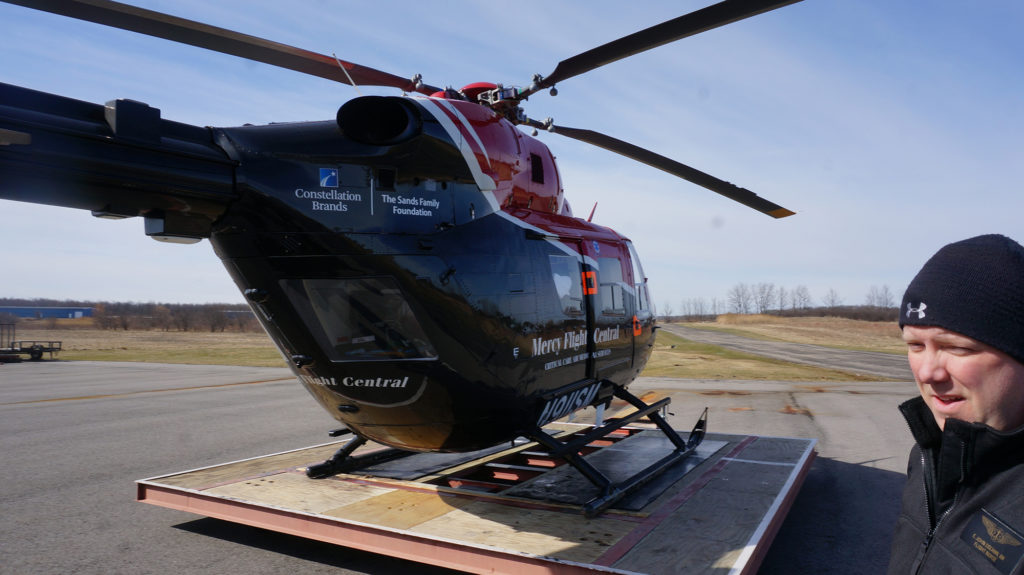
These people are close to each other, and to the communities they serve. During my visit I had the opportunity to join a medical flight team inside an Airbus – 117, to better understand the challenges inherent to this unique and crucial level of medical care. It was evident to me even before my scheduled visit on April 9, 2018 that these folks were some very special people. There is no way you can work in this type of environment and not be. I have never been transported to a hospital – even on the ground – but each time I pull to the side of the road for an approaching emergency vehicle or hear overhead a helicopter, a shiver runs through me and I think about first responders and the all-important work they do.
Given their awe-inspiring roles and impressive backgrounds, I was, I will admit, slightly apprehensive about meeting and talking to the Mercy Flight Central Team Members. My nervousness quickly subsided as I realized how welcoming, down to earth and humble these folks are. This includes all members of the team, from the receptionist at the front desk – as professional and welcoming during subsequent visits as she was during my initial stop by – to President/CEO Jeff Bartkoski, who took the time to talk with me about his role and philosophy related to non-profit emergency care.
Vice President Anita Roberts walked me in and introduced me to Flight Nurse John DeCann and Flight Paramedic John Conceison – members of one of MFCs air medical teams. “John and John” were accompanied by Stephen Diemecke, a fourth semester nursing student at Tompkins Cortland Community College, who was doing a nursing observation with the team as part of his training. Diemecke’s post graduate goal is to work in a research hospital, and his experience at MFC allows him to see first hand some of the many situations he might encounter in this type of hospital setting.
Given the serious nature of the work, the size of the patient care area (tiny) and the potential hazards, I knew that integral teamwork was a significant consideration. Even before I had the opportunity to pose a question related to this, the conversation was set in motion and, in rapid coordinated tandem, DeCann and Conceison provided an overview of the more structured aspects of a day spent waiting for the call. Each day begins with a check of the aircraft and medical equipment with a briefing by the pilot regarding anticipated adverse weather conditions and airspace restrictions (due to factors such as “important people” and air shows). Air emergency pilots follow Visual Flight Rules (VFR) vs. Instrument Flight Rules (IFR), which requires adequate visibility. About 60% of the flights the team makes involve hospital-to-hospital transport of patients. These situations allow for some advance planning – within the team and with coordinating medical personnel at the discharging and receiving hospitals.
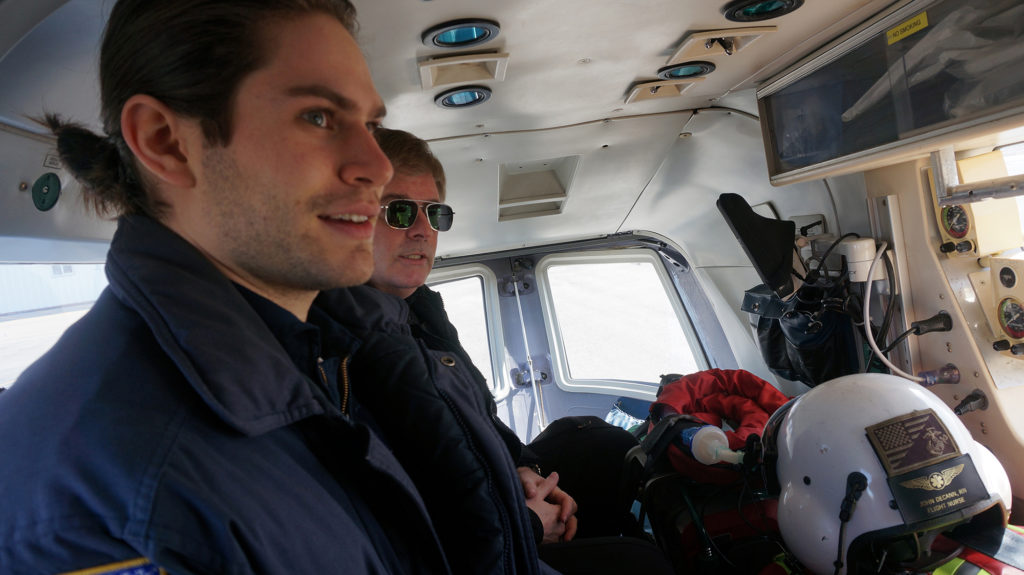
Ambulances on the ground are the first responders in many cases and, after assessing the situation, determine whether or not to put in a call for air transport. Air transport by helicopter (most common) or fixed wing aircraft allows for faster arrival times at hospital trauma care centers, coupled with en route advance life support care. In some places, there are Advanced Life Support Ground Units available. One is MEDIC 55 – which operates out of Soldiers & Sailors Memorial Hospital and responds to traumatic injuries (in Yates County and surrounding counties if requested). Medic 55 is an Advanced Life Support Intercept Vehicle or “fly car” not a patient transport unit. They respond to the initial 911 call and then request air or ground transport after initial ALS care and assessment. In the air trauma care – in most cases as a result of vehicle accidents including ATVs, motorcycles (especially this time of year) and farm machinery – is another area of care funneled via 911 calls through Mercy Flight Central. One or more of their four helicopters are always standing by for immediate departure when needed. Every flight includes at least three people: a pilot, flight nurse and flight paramedic.
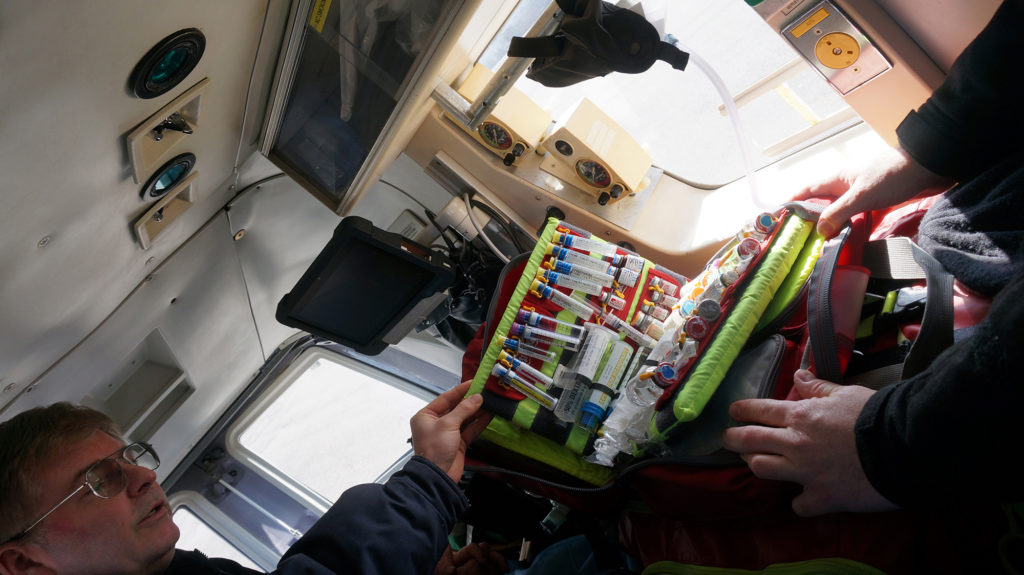
Their extensive training – initially and ongoing – is valuable for emergency air transport as well as ground transport requiring advanced life support. Due to their higher levels of training, MFC staff is sometimes called upon for ground transport requiring higher levels of care. Although each member of each team has some specific responsibilities (The Flight Nurse is specifically responsible for blood work while the Flight Paramedic administers narcotics when necessary) precise and continuous communication is crucial in preparation for flight as well as once they are in the air. The spontaneous and coordinated responses to my questions – even before they were posed – made it evident that this team had established an excellent rapport or, perhaps, mind reading capabilities.
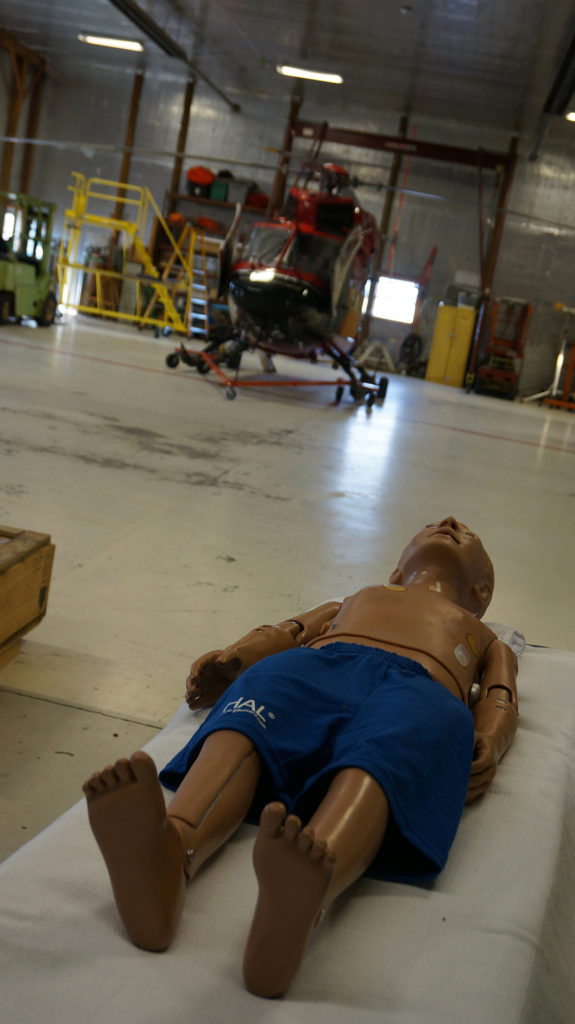
Training well beyond the EMT level is required for the types of care they provide. With very few exceptions, such as in the case of auto-injectors for allergic reactions, EMTs are not allowed to provide treatments that requiring breaking the skin: that means no needles. EMT courses are about 120-150 hours in length. Paramedic courses can be between 1,200 to 1,800 hours. In New York, Paramedics are the highest level of Advanced Emergency Medical Technicians (AEMT) with more extensive training and responsibilities than Intermediate and Critical Care levels. AEMTs are responsible for an expansive array of emergency medical care / advanced life support care. Paramedic responsibilities include stabilizing patients during a medical emergency, preparing patients for transfer to a hospital, if necessary, and providing medical care en route to a hospital. Paramedics may administer drugs (including narcotics) orally and intravenously, perform tracheotomies, and use various monitors and other complex equipment.
Flight paramedics at MFC are required to have a minimum of three (3) years of consistent experience providing patient care at the Paramedic level. Flight Nurses must be Registered Nurses with EMT training, with required trainings in Advanced Cardiac Life Support (ACLS), advanced pediatric life support and CPR. Most of those who take on these roles have far more than the minimally required experience and training, and trainings are ongoing. Flight Nurse John DeCann’s training and experience includes fifteen years as an AEMT followed by eight years in a hospital setting as a Critical Care Nurse. The combination of training and extensive experience, which includes flight time with an experienced Preceptor, means that all members of the team are ready and able to respond when the need arises.
With the sound of an approaching helicopter, chairs were pushed back and everyone moved. We walked through the hanger – where crews were working– toward the landing area. Outside we watched as Pilot Sebastian Ibanez, whom I later had the opportunity to meet along with Flight Paramedic Winnie Romeril, expertly set down a returning Airbus -117. As with many of those I met, Sebastian served in the military – in his case with the Chilean Air Force and the United Nations, flying helicopters as well as fixed wing aircraft. I jumped at the opportunity to speak with Winnie Romeril as she stepped into the hanger post flight – glad that more women are taking on ALS roles. Romeril has been a Flight Paramedic with MFC for ten years. She mentioned during our conversation having taken some time “off” to work in Haiti as a volunteer, describing it, quite understatedly, as a “very different medical setting” than what is available here. She elaborated: “In one case, we transported a preemie in a soft-sided lunch cooler, to keep the infant warm.” She shared this experience in a quiet, matter-of-fact way, but there was so much more. What she failed to share with me – and I learned from others later – was the extent of her role with the American Red Cross, where she has served nationally and internationally as a bilingual communicator. She is a member of the national Advanced Public Affairs Team and an Emergency Response Unit delegate for international catastrophic disaster response. She seemed so relaxed when I met her and perhaps her work here, despite it being dangerous and stressful, was relaxing in comparison to her experiences in Haiti and places like Sierra Leone during the Ebola outbreak, Mississippi during Hurricane Katrina, and Canada during the Alberta Wildfires.
I realized as my time on site continued that the same could be said for all members of the Mercy Flight Central family. Walking back through the hanger, I had met Director of Aviation Operations, James Mizerak, and Pilot Joe Carr – the third crucial member of the air medical team I was spending the morning with. The inclination to remain humble and low key about respective roles was what I encountered here as well. In listening in, with some slight prompting on my part, I learned that these folks came to the organization with significant prior experience including many years of active military service. Both Carr and Mizerak had twenty or more years of active military service – Carr flew reconnaissance missions and Mizerak attack helicopters. Their work at MFC, they shared, was a chance to save lives – to take a different role. “The medical teams are the ones who save lives,” Joe – who has flown 255 patients in four years – quickly added, “We just get them there.”
I love being in the air, and seeing (and feeling) helicopters land and take off is an exhilarating experience. I have always been fascinated by these machines (and smaller fixed wing craft) and will step outside and watch as they fly over (likely a very different response than those who have lived and worked in war zones). This was the first time I had experienced being inside – seeing first hand just how it feels to be sandwiched into this amazingly small, amazingly well outfitted mini medical unit. The BK – 117, now the Airbus – 117 helicopters were jointly developed by Kawasaki and Messerschmitt-Bölkow-Blohm (MBB) of West Germany (currently known as Airbus Helicopters Deutschland GmbH [AHD]). In 1982, this two-engine, multipurpose, high-performance helicopter was type approved as the first domestically-manufactured helicopter. They are designed and marketed for a wide range of applications. I had to chuckle when I read the online blurb about their use for emergency medical transport. “With a roomy cabin, despite its compact external dimensions, the Airbus -117 has become a best-selling model and a preferred choice among healthcare professionals.” It was hard to believe that the Airbus – 117 was, in comparison to earlier transport helicopters, a roomy cabin space (with an ability to carry up to eight adults and extensive medical equipment) as I settled in with the two John’s and Stephen. The patient bed was at our knees, with little room to maneuver. And when in flight it is loud. Communication happens via microphone-equipped helmets.
Mercy Flight Central is unique in so many ways. Foremost is their non-profit status, an emphasis shared by Jeff Bartkoski during our discussion time following my host team’s departure. With no stockholders, they can keep patient cost lower while focusing first and foremost on saving lives. Bartkoski (4 years this June) joined MFC after thirty years in the Navy. He had served at University of Rochester as an ROTC Commander and wanted a community-based position. Mercy Flight Central fit well with his philosophy and skill set. Non-profits, based on my experience working for a number of different such agencies, are never able to pay their staff as much as for profit businesses. This means that people in these roles are highly dedicated individuals with a passion for what they are doing – this is true at all levels. They are a family and a team, connected with caring and generous individuals and organizations that respect and support what they do.